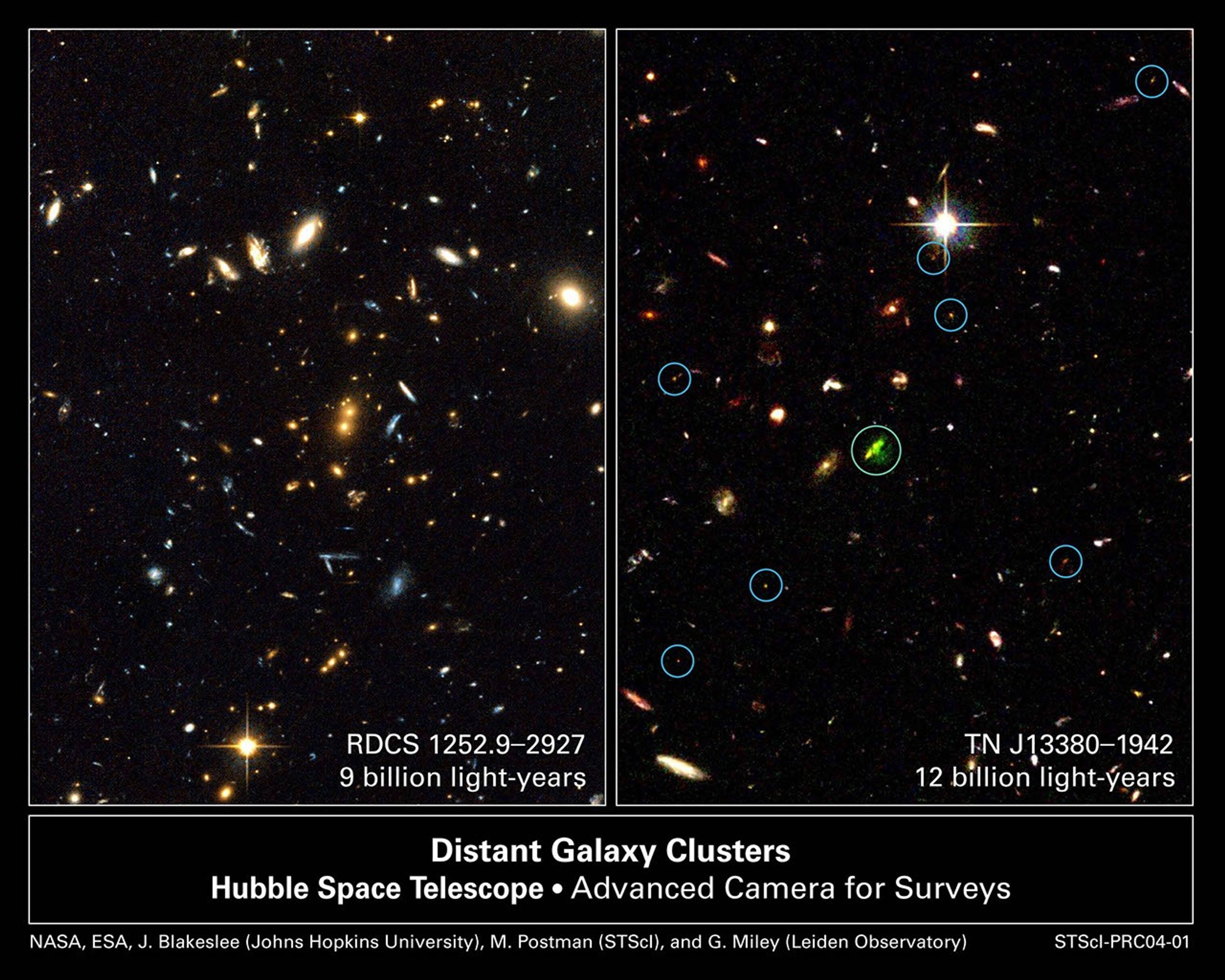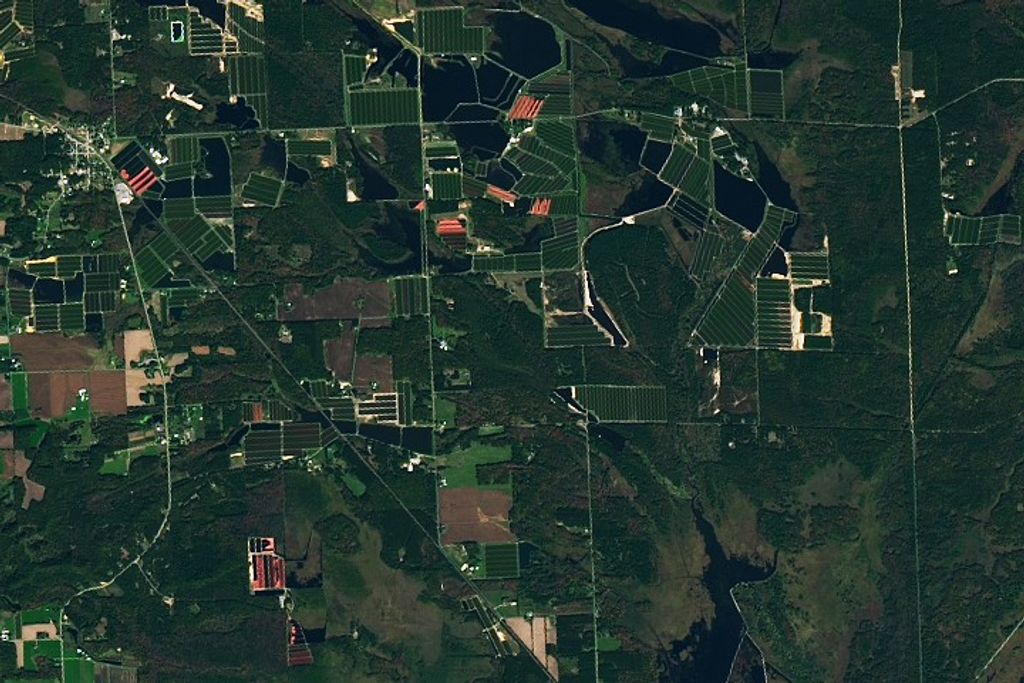1 min read
A Tale of Two Record-Breaking Galaxy Clusters

Looking back in time to when the universe was in its formative youth, the Advanced Camera for Surveys (ACS) aboard NASA's Hubble Space Telescope captured these revealing images of two galaxy clusters.
The image at left shows mature galaxies in a massive cluster that existed when the cosmos was 5 billion years old. The cluster, called RDCS 1252.9-2927, is as massive as 300 trillion suns and is the most massive known cluster for its epoch. The Hubble image reveals the core of the cluster and is part of a much larger mosaic of the entire cluster. Dominating the core are a pair of large, reddish elliptical galaxies [near center of image]. Their red color indicates an older population of stars. Most of the stars are at least 1 billion years old. The two galaxies appear to be interacting and may eventually merge to form a larger galaxy that is comparable to the brightest galaxies seen in present-day clusters.
The red galaxies surrounding the central pair are also cluster members. The cluster probably contains many thousands of galaxies, but only about 50 can be seen in this image. The full Hubble mosaic reveals several hundred cluster members. Many of the other galaxies in the image, including several of the blue galaxies, are foreground galaxies. The color-composite image was assembled from observations taken between May and June 2002 by the ACS Wide Field Camera.
In the image at right, astronomers are seeing an embryonic cluster as it was when the universe was 1.5 billion years old. The young system, called TN J1338-1942, is the most distant known developing cluster, or proto-cluster. It is dominated by a massive "baby galaxy," the green object in the center with the blue circle around it. The galaxy is producing powerful radio emissions, and is the brightest galaxy in the proto-cluster. The green color indicates that the galaxy is emitting glowing hydrogen gas. Its clumpy appearance suggests that it is still in the process of forming. Smaller developing galaxies, marked by the blue circles, are scattered around the massive galaxy. The galaxy on the left of the massive galaxy is a foreground galaxy. The bright object in the upper half of the image is a foreground star. This color-composite image was assembled from observations taken between July 8 and 12, 2002 by the ACS Wide Field Camera
About the Data
- Data DescriptionData DescriptionProposal: A description of the observations, their scientific justification, and the links to the data available in the science archive.
Science Team: The astronomers who planned the observations and analyzed the data. "PI" refers to the Principal Investigator.RDCS 1252.9-2927 image (left) The field was imaged by Hubble during proposal 9290: H. Ford (JHU), M. Postman (STScI), M. Franx (University of Leiden), J. Blakeslee (JHU) and P. Rosati (ESO). The science team presenting the science results on this object includes J. Blakeslee (JHU), M. Franx (Leiden Observatory), M. Postman (JHU/STScI), P. Rosati (ESO), B. P. Holden (UCO/Lick), G. D. Illingworth (UCO/Lick), H. C. Ford (JHU), N. J. G. Cross (JHU), C. Gronwall (JHU), N. Benítez (JHU), R. J. Bouwens (JHU), T. J. Broadhurst (Hebrew University), M. Clampin (STScI), R. Demarco (ESO), D. A. Golimowski (JHU), G. F. Hartig (STScI), L. Infante (Pontificia Universidad Catolica de Chile), A. R. Martel (JHU), G. K. Miley (Leiden Observatory), F. Menanteau (JHU), G. R. Meurer (JHU), M. Sirianni (JHU) and R. L. White (JHU/STScI). TN J1338-1942 image (right) The field was imaged by Hubble during proposal 9291: H. Ford (JHU), G. Miley (Leiden Observatory), W. Sparks (STScI), Z. Tsvetanov and H. Tran (JHU). The science team presenting this paper includes G. K. Miley (Leiden Observatory), R. A. Overzier (Leiden Observatory), Z. I. Tsvetanov (JHU), R. J. Bouwens (UCO/Lick), N. Benítez (JHU), J. Blakeslee (JHU), H. C. Ford (JHU), G. D. Illingworth (UCO/Lick), M. Postman (STScI), P. Rosati (ESO), M. Clampin (STScI), G. F. Hartig (STScI), A. W. Zirm (Leiden Observatory), H. J. A. Röttgering (Leiden Observatory), B. P. Venemans (Leiden Observatory), D. R. Ardila (JHU), F. Bartko (Bartko Sci. & Tech), T. J. Broadhurst (Hebrew University), R. A. Brown (JHU), C. J. Burrows (JHU), E. S. Cheng (NASA-GSFC), N. J. G. Cross (JHU), C. De Breuck (ESO), P. D. Feldman (JHU), M. Franx (Leiden Observatory), D. A. Golimowski (JHU), C. Gronwall (JHU), L. Infante (Pontificia Universidad Catolica de Chile), A. R. Martel (JHU), F. Menanteau (JHU), G. R. Meurer (JHU), M. Sirianni (JHU), R. A. Kimble (NASA-GSFC), J. E. Krist (STScI), W. B. Sparks (STScI), H. D. Tran (JHU), R. L. White (STScI), and W. Zheng (JHU). - InstrumentInstrumentThe science instrument used to produce the data.HST>ACS/WFC
- Exposure DatesExposure DatesThe date(s) that the telescope made its observations and the total exposure time.May - June, 2002 (left), and July 9 - 12, 2002 (right)
- FiltersFiltersThe camera filters that were used in the science observations.RDCS 1252: F775W (i) and, F850LP (z) TN J1338: F475W (B), F625W (z), F775W (i)
- Object NameObject NameA name or catalog number that astronomers use to identify an astronomical object.RDCS 1252.9-2927,TN J1338-1942
- Object DescriptionObject DescriptionThe type of astronomical object.Distant Galaxy Clusters
- Release DateJanuary 1, 2004
- Science ReleaseImages from Hubble’s ACS Tell a Tale of Two Record-Breaking Galaxy Clusters
- CreditRDCS 1252 image: NASA, ESA, J. Blakeslee (Johns Hopkins University), M. Postman (Space Telescope Science Institute), and P. Rosati (European Southern Observatory); TN J1338 image: NASA, ESA, G. Miley (Leiden Observatory), and R. Overzier (Leiden Observatory)
Share
Details
Claire Andreoli
NASA’s Goddard Space Flight Center
Greenbelt, Maryland
claire.andreoli@nasa.gov
































